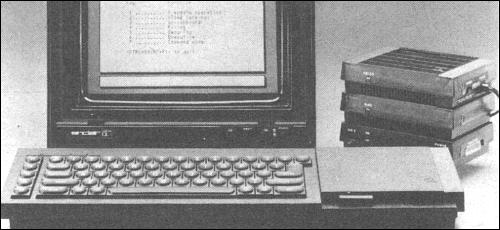| QL Hardware World |
THE DEMISE of OEL left Sinclair with rather more egg on its face than usual. It had just spent a bob or two on full page colour adverts for QCOM, a communications/modem package for the QL, and by the time the ads appeared, OEL had disappeared.
Tandata, who already supplies a number of very nice modems for other computers, has now taken up QCOM and the finished product should be available soon.
QCOM comprises three parts, QCON, QCALL and QMOD, which stack neatly on top of one another and are styled to match the QL. The base unit, QCON, is the heart of the system and is the minimum required; the other units are optional.
QCALL provides auto dial and auto answer and QMOD is the modem.
QCON connects to the QL SER2 port and takes its power direct from the QL power supply, the QL is then powered from QCON. It is supplied with the Scion software and it is that which makes it so good.

The Scion software loads in two stages; first a short Basic boot program which asks you to input the date and time, and then the code proper. A main menu is displayed with everything neatly laid out and windowed, and from that follows a series of sub menus.
The first option, and probably the one which will get most use, is Viewdata, through which you can access Prestel.
The second option is entitled VT100 and is a full terminal emulation of the industry standard for connection to mainframes. The sub menu allows you to log on, hang up, alter various settings - which can be saved for future use or reset to default or go into terminal mode. These options are standard but QCON comes into its own with the next four.
Switchboard, option three, is the phonebook which stores pages of telephone numbers. Each page has its own default settings, which can be changed. Each entry has several options, the phone number can be set on dial and there is space for a comment. That last can be set so that it is automatically sent when you log on.
Option four gives you access to the QDOS filing system and with this you can list or delete a file, and obtain a directory.
The last two options on the main menu allow you to build a file of commands and run them. The commands available are quite extensive; if you had QCALL connected you could set it to 'phone Prestel at a certain time, access a page, save it to microdrive, and hang UP.
The limitations to the system is QMOD. It can only run at 1200 or 75 baud, and although many information providers use those rates, 300 baud is still popular. OEL had applied for British Telecom approval but the process was suspended when the company ran into difficulties.
The prices of the individual units are QCON £89.95, QCALL £49.95 and QMOD £79.95 - a total price of £219.85.
For further details and availability contact Tandata Marketing Ltd, Worcestershire.
QUEST was one of the first companies to announce support for the QL with both hardware and software. Last month we looked at its add-on RAM, and this month we turn to disc drives and the CP/M 68K operating system.
The disc interface is housed in the same, over large, case as the RAM.
Before the drives can be used the disc operating system has to be loaded from microdrive, an archaic practice, but otherwise the EPROM-based software would interfere with running CP/M. The result is that memory is used up which, if you load a large program, such as Quill, requires it to access the disc more often than would otherwise by necessary.
Once up and running the disc behaves in much the same way as a microdrive, using FDV in place of MDV. It competes with the microdrive in speed, and loses. Saving can take up to twice as long, although loading is quicker. Booting a program takes an age.
To format a disc the software again has to be loaded from cartridge.
One area where the discs are useful is in running CP/M 68K. It can be run solely from cartridge but requires an additional operating system card. We looked at the disc-based system, as with the DOS it has to be booted from cartridge. The microdrives are treated as A> and B>, floppies as C> and D>.
CP/M 68K is supplied with a large manual and two discs with a number of utilities. The discs contain a C compiler, an assembler and a text file.
The system can read and write files to IBM format discs and there is a utility which will convert QDOS files to CP/M 68K format.
CP/M 68K costs £59.50 on disc, £99.50 on cartridge. The disc drives, all 5¼in including interface, are 1x200K £295.00, 1x400K £1419.00, 1x800K £499.00, 2x200K £469.00, 2x400K £579.00 and 2x800K £695.00.
If you are looking for a disc system only then there are better and cheaper ones available. If you want to run CP/M 68K then this is the only system around.
Contact Quest Automation Plc, Hampshire.